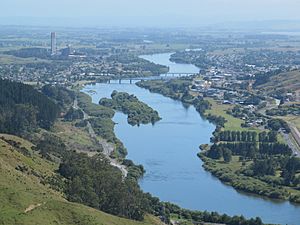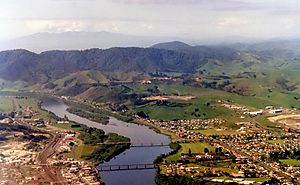Huntly, New Zealand facts for kids
Quick facts for kids
Huntly
Rahui-Pōkeka (Māori)
|
|
|---|---|
|
Minor urban area
|
|

Waikato River, Huntly and Huntly power station from Hakarimatas in 2012
|
|
| Country | New Zealand |
| Region | Waikato |
| District | Waikato District |
| Ward | Huntly Ward |
| Community | Huntly Community |
| Electorates |
|
| Area | |
| • Total | 16.57 km2 (6.40 sq mi) |
| Elevation | 15 m (49 ft) |
| Population
(June 2023)
|
|
| • Total | 8,880 |
| • Density | 535.9/km2 (1,388.0/sq mi) |
| Postcode(s) |
3700
|
Huntly (also known as Rahui-Pōkeka in Māori) is a town in the Waikato region of New Zealand's North Island. It is located about 95 kilometers (59 miles) south of Auckland and 32 kilometers (20 miles) north of Hamilton. The town sits right on the Waikato River and is served by the North Island Main Trunk (NIMT) railway line.
Contents
Discovering Huntly's Past
Huntly has a rich history, especially with the Māori. European settlers first arrived in the area around the 1850s. The name Huntly was chosen in the 1870s by the local postmaster. He named it after Huntly, Aberdeenshire in Scotland. He even used an old "Huntley Lodge" stamp for mail. Later, "Lodge" was dropped, and the spelling changed to "Huntly."
The railway line from Auckland reached Huntly in 1877. This was a big event for the town. The Huntly railway station opened that same year.
Māori Heritage and Culture
Huntly is very important to Māori history. It is part of the rohe (tribal area) of Waikato-Tainui. This is a large group of tribes from the Tainui waka (canoe). The local subtribes, called hapū, are Ngāti Mahuta and Ngāti Whawhakia.
Waahi Pa, a special meeting place in Huntly, was once home to the Māori queen, Dame Te Atairangikaahu. It was also home to her son, the current Māori king, Tūheitia.
Schools and Learning
Rakaumanga Native School was started in 1896. In 1974, it moved to make way for the Huntly Power Station. This school became one of New Zealand's first bilingual schools in 1984. This meant teaching in both Māori and English. In 1994, it became a kura kaupapa. This is a school where all teaching is done in the Māori language. Today, it is known as Te Whare Kura o Rakaumangamanga.
Marae: Special Meeting Places
A marae is a sacred meeting ground for Māori people. There are several important marae in and around Huntly. These include Kaitumutumu Marae, Te Kauri Marae, Te Ōhākī Marae, and Waahi Pa. These places are linked to the Ngāti Kuiaarangi, Ngāti Mahuta, Ngāti Tai, and Ngāti Whāwhākia hapū.
In 2020, the government helped upgrade Waahoi Marae and seven other marae in the Waikato Tainui area. This project also created 40 jobs.
People of Huntly
Huntly covers about 16.57 square kilometers (6.40 square miles). In 2018, the town had a population of 7,905 people. This was a good increase from previous years.
Who Lives in Huntly?
In 2018, the main ethnic groups in Huntly were:
The town is split into two areas for statistics: East and West. Huntly West has a higher percentage of Māori people.
About 12.3% of people in Huntly were born overseas. This is lower than the national average for New Zealand.
Beliefs and Work
Many people in Huntly (52.2%) said they had no religion in 2018. About 30.3% were Christian. Some people also followed Māori religious beliefs (4.5%).
When it comes to jobs, about 42.8% of people aged 15 or older worked full-time. Another 11.1% worked part-time. About 7.7% were unemployed.
Huntly's Major Industries
Huntly is known for its big industries, especially power generation and coal mining.
Huntly Power Station
The Huntly Power Station is a very large power plant. It uses gas and coal to make electricity. You can see it clearly on the western bank of the Waikato River. It is New Zealand's biggest thermal power station. The area around Huntly is also New Zealand's largest producer of coal. Over 10,000 tonnes of coal are produced here every day.
Huntly is also surrounded by farms and lakes. Many of these lakes used to be open-pit mines. Today, they are used for fishing, yachting, and waterskiing.
Coal Mining in Huntly
The Waikato coalfield has very old rocks, about 30 to 35 million years old. Coal mining has a long history here. Both open-cast (mining from the surface) and underground mines have operated. The coal mined here is mainly used by the power station and the New Zealand Steel mill.
The first coal was mined in 1849 at Taupiri. More mines opened over the years. Sadly, on September 12, 1914, a terrible explosion at the Ralph Mine in Huntly killed 43 coal miners.
Open-cast mining started west of Huntly during World War 2. Later, another open-cast mine opened at Kimihia.
O’Reilly’s Opencast Mine
This mine was the last one operating in Huntly itself. It opened in 1957 and mainly sold coal to New Zealand Steel. It closed in 2018. Today, only the Puke Mine and Rotowaro mines are still open in the wider Huntly area.
Huntly East Coalmine
This large mine closed on October 22, 2015. It had opened in 1978 and produced a lot of coal. By 2012, all mining was happening west of the Waikato River. The mine had tunnels 150 meters (492 feet) below the river. The coal seams were 150 to 400 meters (492 to 1,312 feet) deep. Coal was dug using special remote-controlled machines. It was then carried by conveyor belt to the surface.
Brick Making
The clay found on top of some coal deposits is perfect for making bricks. Brick making started in Huntly in 1884. A company called Huntly Brick and Fireclay was set up in 1911. Today, Shinagawa Refractories still operates on the same site. Another company, Clay Bricks, also has a brickworks nearby.
Rugby League in Huntly
Huntly has a very strong history in rugby league. At one time, the town had four rugby league clubs: Taniwharau, Huntly South, Huntly United, and Rangiriri Eels. Taniwharau has been one of the most successful clubs. They won 11 Waikato premierships in a row during the 1970s and 1980s.
Many famous New Zealand rugby league players have come from Huntly. These include players like Tom Timms, Len Mason, Tawera Nikau, and Lance Hohaia. The town has also produced many Māori Rugby league representatives. Two international referees, Arthur Harlock and Roland (Roly) Avery, also came from Huntly.
Bridges of Huntly
Huntly has important bridges that cross the Waikato River and local roads.
Rail Bridge
In 1915, a road and rail bridge was built. It replaced an older punt (a type of ferry) that had been used since 1894. This new bridge helped connect the Pukemiro railway.
Tainui Bridge
The Tainui Bridge is a special bowstring-arch bridge for road traffic. It opened in 1959. After it opened, the 1915 bridge became only for trains. A footbridge was also added to the side of the old bridge.
The Tainui Bridge was made stronger in 2005. This allowed very heavy 500-tonne turbines to be carried across it to the Power Station. In 2011, it was made even stronger to withstand earthquakes. The bridge was repainted in 2016.
Footbridge
There is also a footbridge that crosses Shand Lane, the main highway (SH1), and the railway line. This bridge connects Glasgow Street with Main Street. In 2010, the middle part of the bridge was raised. This was to allow tall trucks carrying parts for the Te Uku Wind Farm to pass underneath.
Education in Huntly
Huntly has five schools that teach both boys and girls.
- Huntly College is a state secondary school for students in years 9 to 13. It opened in 1953.
- Huntly School and Huntly West School are state primary schools. They teach students from years 1 to 8.
- St Anthony's Catholic School is a state-integrated primary school. It also teaches students from years 1 to 8.
- Te Wharekura o Rākaumangamanga is a state school that covers years 1 to 13. It provides education completely in the Māori language.
The nearby area of Kimihia also has a primary school called Kimihia School.



